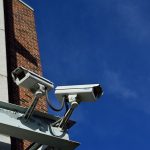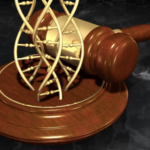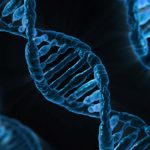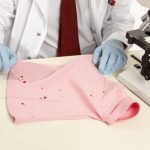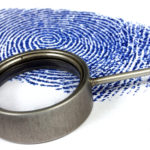Interpreting Blood Stain Patterns: Science or Speculation?

In the TV-show Dexter, the titular character leads a double life as both a forensic scientist and a serial killer. Dexter’s unique forensic speciality is bloodstain pattern analysis, which is an attempt to help in the reconstruction of violent crimes by examining blood left at the scene.
This all makes for compelling television, but how scientific is blood stain pattern analysis, and what can it actually show?
Deciphering The Blood
Specialists in bloodstain pattern analysis – which is sometimes called “blood spatter analysis” – look at the physical characteristics and angles of impact left by blood stains as a result of alleged violent attacks.
Bloodstains may be clearly evident at the scene, or visualised through the use of special lighting (such as UV light) or chemical treatment, such as the use of Luminol, which makes blood briefly luminescent via a chemical reaction.
Certain types of violence are said to leave distinctive blood stain patterns. For example, a very diffuse spatter of blood is consistent with a high velocity wound, either from a gunshot or some form of blunt force trauma. In contrast, droplets of blood left at the scene could indicate a “passive pattern” more consistent with a stabbing.
Some of the forensic opinions that are derived from interpreting blood stain patterns include:
- The direction from which blood originated,
- The location or position of a victim at the time a bloody wound was inflicted,
- The movement of a bleeding individual at the crime scene,
- The minimum number of blows that struck a bleeding victim, and
- The approximate location of an individual delivering blows that produced a bloodstain pattern.
Although there are general rules of thumb when it comes to interpreting blood stains, the process of reconstructing a crime scene based on pattern characteristics is largely left up to the judgment of analysts.
How Accurate is Blood Stain Pattern Analysis?
Interpreting blood stain patterns is ultimately a highly subjective process, meaning the accuracy of any opinion given is likely to depend greatly on the skill of the analyst.
A recent study published in Forensic Science International, found that conclusions made by bloodstain pattern analysts were often incorrect and contradictory. The research found that on samples with known causes, over 1 in 10 interpretations made by bloodstain pattern analysts were demonstrably incorrect.
Inaccurate and unreliable conclusions made on the basis of blood stain patterns have been seen in a number of high-profile miscarriages of justice.
In 1965, Alexander McLeod-Lindsay was convicted of the brutal bashing and attempted murder of his wife and son on the basis of inaccurate blood stain patterns. Mcleod-Lindsay’s wife, Pamela McLeod-Lindsay and four-year-old son were severely injured following an attack by an assailant in their Sydney home.
A key component of the prosecution’s case was that Mcleod-Lindsay’s clothing contained “impact spatter” which could only have occurred if he participated in the violent assault. Pamela Mcleod-Lindsay was adamant that it wasn’t her husband that attacked her, noting that the unseen assailant had an Australian accent, whilst her husband’s accent was Scottish.
Nevertheless, Mcleod-Lindsay was convicted by a jury and sentence to 18 years imprisonment. Public attention to the case soon led to other forensic experts noting that the pattern on Mcleod-Lindsay’s clothing could be explained as an “expiration pattern”, as when Mcleod-Linday returned home to discover his wife bleeding on the floor and she coughed blood on him.
Given the tenuous evidence against him, Mcleod-Lindsay was pardoned after serving nine years in prison and received $700,000 in compensation
Challenging Blood Stain Pattern Analysis
Potential inaccurate forensic evidence such as blood stain pattern analysis can be challenged in two ways at trial: (1) by arguing the evidence is inadmissible or; (2) by cross-examining prosecution experts during jury trials with a view to undermining the reliability of their techniques and, indeed, their evidence.
Whether forensic evidence is admissible depends on who is giving the evidence, how it is being used and the relevance of the evidence at trial. Some common objections to admissibility under the Uniform Evidence Act include:
- The opinions given by the forensic specialist are not based on their specialised knowledge (as required under s 79 of the Act).
- The evidence is not relevant to the probability of the existence of a fact in issue in the proceeding (s55 of the Act).
- The evidence is insufficiently probative or unfairly prejudicial to the accused (s135-137).
Unlike in other countries, there is no requirement that forensic evidence presented at trials in Australia be based on sound scientific knowledge. As such, it’s often the role of defence lawyers to challenge the reliability and validity of any forensic technique.
During cross-examination, defence counsel can challenge forensic evidence by proposing innocent explanations for the findings, noting common flaws in forensic techniques and challenging the robustness of forensic opinion.
Defence counsel can also call their own independent forensic experts who may disagree with the conclusions of the prosecution’s expert witness.
Update: ‘Junk Science’ Threatens Convictions
The use of ‘junk science’ within the Australian Court system has brought into question whether blood stain patterns can be successfully used for convictions. The validity of the science was highlighted during the conviction of Robert Farquarson in 2023 for the murder of his three sons back in 2005, with issues regarding scientific and medical testimony that didn’t hold up in court over the years.
The United States National Academy of Sciences and the Australian Academy of Sciences both mentioned that the accuracy of reports involving fingerprints, hairs, handwriting, bite marks, paints, and blood stains might not be 100% foolproof. For example, fingerprint examiners are not infallible, with 1 in 400 not accurate, along with forensic dentists unable to prove that a bite mark on skin actually belongs to human teeth.
Thus, the accuracy of blood splatters is also in question. Australian courts have failed to maintain a high standard of reliability in the court, as they have ignored scientific reports and academic theories that show the courts need to crack down on the rules and regulations for what type of evidence is admissible in court.
Overall, blood splatter might not be considered reliable in today’s modern world.
Case Study: The Staircase
One of the most well-known case studies that show how blood splatter is not reliable in the courts is the The Staircase trial, which involved Michael Peterson, a man who was convicted of killing his wife after extremely controversial evidence found in their home after a ‘fall’ down the stairs. The blood splatter patterns ‘proved’ that Michael killed his wife by hitting her with a blunt object, supposedly a blow poe, that caused her to fall down the staircase.
However, the blood splatter analyst who worked for the North Carolina Bureau of Investigation, lied about his credentials and falsified evidence in Peterson’s trial — and 33 other cases. Real Experts, like Dr. Niki Osborne, who is a forensic research scientist in New Zealand, stated that there is ‘ambiguity in bloodstain patterns’, with bloodstain spatter analysis ‘at risk of bias’.

